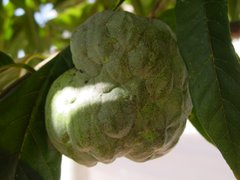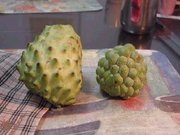Sugar-apple
|
|
| Sugar-apple | ||||||||||||||
|---|---|---|---|---|---|---|---|---|---|---|---|---|---|---|
 Sugar-apple fruit | ||||||||||||||
| Scientific classification | ||||||||||||||
|
The Sugar-apple (Annona squamosa), also known in English as Sweetsop and Scaly Custard-apple, is a species of Annona native to the tropical New World. It is a deciduous or semi-evergreen shrub or small tree reaching 8 m tall. The leaves are alternate, simple, oblong-lanceolate, 7-12 cm long and 3-4 cm broad. The flowers are produced in clusters of 3-4, each flower 2-3 cm across, with six petals, yellow-green spotted purple at the base.
The fruit is usually round or slighly pine cone-like, 6-10 cm diameter, with a scaly or lumpy skin. The fruit flesh is white, and resembles and tastes like custard. The name "custard-apple" is frequently, though technically incorrectly, used to refer to this species.
It is the most widely cultivated of all the species of Annona, being grown widely throughout the tropics and warmer subtropics. Different cultures have their unique names for the sugar-apple. For instance, in Latin America it is known by a variety regional names such as anón, anón de azucar, anona blanca, fruta do conde, cachiman, guanabana, and many others. The Taiwanese call the sugar-apple shijia (Sakya, 釋迦; Taiwanese: sek-khia) because one variety resembles the top part of Sakyamuni's (釋迦牟尼) head. In India it is commonly called Sitaphal (literally meaning "Sita fruit").
Sugar_apple_flesh.JPG

